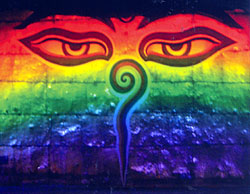 Documentary filmmaking in Nepal has grown tremendously in recent years. The subjects and themes explored have, unfortunately, not. A welcome change is Imagine Rainbow in Kathmandu, by didgeridoo performer Salil Kanika and visual designer Thomas Bertschi. This 98 minute-long film, refreshingly new in technique as well as subject, envisions hope and future in a society devastated by war.
Documentary filmmaking in Nepal has grown tremendously in recent years. The subjects and themes explored have, unfortunately, not. A welcome change is Imagine Rainbow in Kathmandu, by didgeridoo performer Salil Kanika and visual designer Thomas Bertschi. This 98 minute-long film, refreshingly new in technique as well as subject, envisions hope and future in a society devastated by war.
Shot in Kathmandu Valley between November 2005 and April 2006, Rainbow begins with portraits of urban wastelands and shots of street children whose future seems even murkier than their dirty hands and faces and greasy hair. Bertschi, artist, visual designer, traveller, and long-time friend of Nepal, found common ground with Kanika in their dedication to giving children a voice through art.
As the film progresses, professional artists work with groups of children from different social and economic backgrounds, slowly teaching them the basics of music and painting. Eventually you see hope, excitement, and self-discovery in the children's eyes.
The five groups of children worked on much more than just music and painting�they painted faces, banners inspired by traditional ceremonial Balinese Umbal flags and school buildings, and played instruments they made themselves. At the end of the film, each group�the sarangi orchestra, the rock chorus, the drummers, the didgeridoo players, and chanters of Buddhist verses�give a grand performance.
The rainbow�inspired by the Australian aboriginal myth of the Rainbow Snake, creator of growth and fertility�is an appropriate image. The performance evokes�even in cynics�the possibility that we can create a more beautiful world.
Proceeds from Imagine Rainbow in Kathmandu will go towards providing further musical and cultural education for children.
Alok Tumbahangphey


